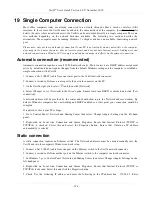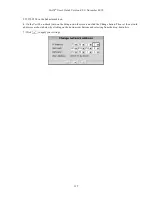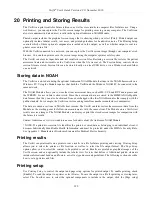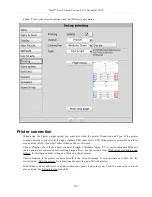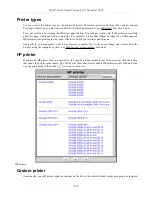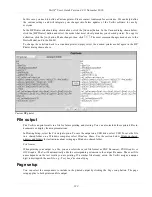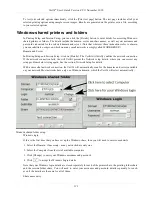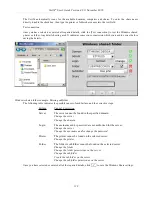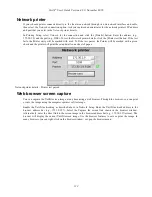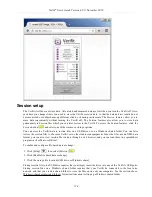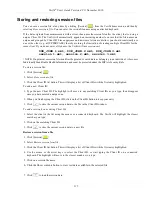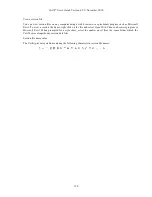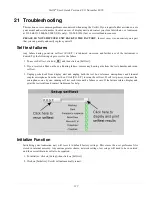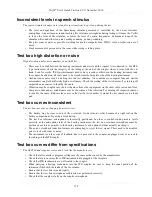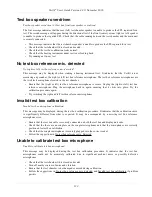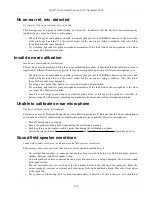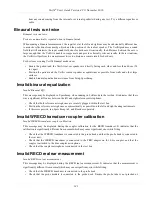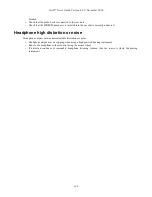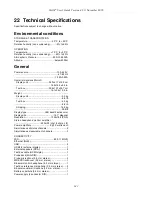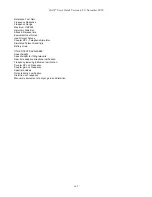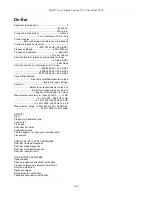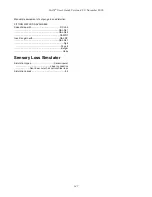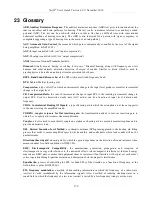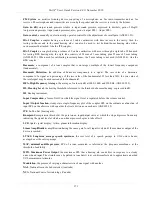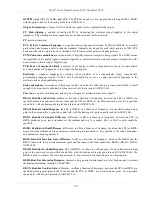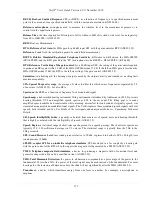
Verifit
®
User's Guide Version 4.8
©
November 2016
Inconsistent levels in speech stimulus
The speech stimulus changes in level and/or spectrum from loop to loop during the test.
•
The level and spectrum of the Speechmap stimulus presented is controlled by the on-ear reference
microphone. Any extraneous sound reaching this reference microphone during testing will cause the Verifit
to lower the level of the stimulus, or lower the level of certain frequencies. Subsequent loops of the
stimulus will sound either too quiet, muddy-sounding, or tinny-sounding.
•
Keep test room as quiet as possible, watching for nearby computer fans, HVAC vents, or other sources of
noise.
•
Limit movement of personnel in the room while testing is taking place.
Test box high distortion or noise
High distortion and/or noise numbers in an ANSI test
•
There may be a leak between the hearing instrument under test and the coupler it is connected to. For BTE
type instruments, check the integrity of the tubing at the end of the coupler where it joins with the ear
hook. Look for cracks. ITE type instruments need to have a good seal between the hearing instrument and
the coupler. In addition, all vents need to be closed from the faceplate side of the hearing instrument.
•
Ambient room noise may be leaking into the test chamber. Air conditioners, computer fans and similar
noisemakers can yield artificially high noise figures. Check the sealing of the test chamber. Try turning off
suspected noise sources to identify the cause.
•
Vibration may be coupled into the test chamber from other equipment on the same table or wooden floor.
Computers, fans and air conditioners may be the source of the vibration. Try turning off suspected sources
to identify the cause. Relocate the source or the Verifit test chamber or mount the test chamber on a foam
pad.
Test box curves inconsistent
The test box curves keep changing from test to test.
•
The battery may be close to end of life or starved for air (zinc-air cells) because of a tight seal on the
battery compartment. Try using a fresh battery.
•
The test box reference microphone is incorrectly positioned. In order to control sound pressure levels
precisely at the microphone inlet of the hearing instrument, the test box reference microphone must be
positioned as close as possible to the hearing instrument’s microphone without actually touching it.
•
The noise or feedback reduction features are attempting to reject the test signal. These need to be disabled
prior to tests with tones or noise.
•
The instrument is on the verge of feedback due to a poor seal to the coupler, unplugged vent or a crack in
the tubing on the BTE coupler.
Test box curves differ from specifications
The OSPL90 and response curves don’t look like the manufacturer’s.
•
Check that all controls or program settings are the same as those used by the manufacturer.
•
Check that vents on earmolds or ITE instruments are plugged at the faceplate.
•
Check that ITE instruments are well sealed to the coupler.
•
When puttying a hearing instrument into the ITE coupler, be sure to keep the canal portion of the
instrument flush with the inside of the 2cc volume.
•
Ensure that the test box is sealed tightly.
•
Ensure that the test box microphone calibration was performed correctly.
•
Check that the coupler is fully on the coupler microphone.
138
Summary of Contents for verifit
Page 1: ...Audioscan Verifit User s Guide 4 8 November 2016...
Page 17: ...Verifit User s Guide Version 4 8 November 2016 EC Declaration of Conformity 17...
Page 92: ...Verifit User s Guide Version 4 8 November 2016 92...
Page 94: ...Verifit User s Guide Version 4 8 November 2016 94...
Page 107: ...Verifit User s Guide Version 4 8 November 2016 Telecoil test results 107...
Page 123: ...Verifit User s Guide Version 4 8 November 2016 123...
Page 148: ...Verifit User s Guide Version 4 8 November 2016 148...
Page 149: ...Verifit User s Guide Version 4 8 November 2016 149...
Page 159: ...Verifit User s Guide Version 4 8 November 2016 159...

